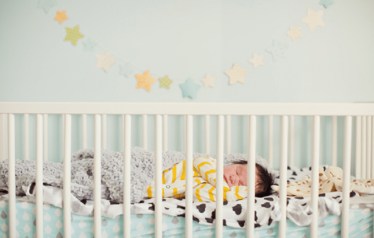[heading tag=”h2″ align=”center” color=”#000″ style=”lines” color2=”#000″]In this Article[/heading]
How to create best conditions for Babies nap
Steps for building sleeping routine of Baby
[divider height=”30″ style=”default” line=”default” themecolor=”1″]
One of the most beautiful moments of parenthood is having your baby doze off securely in your arms. Although getting the other chores done through this process can be quite a task.
From sharing a bed with you to sleeping on their own in a crib, preparing for the kid for such a transition big! So, take this with a pinch of salt as it might be a shocking and abrupt change in your little one’s lifestyle.
According to The American Academy of Sleep Medicine’s guidelines, babies who are under one year of age need 12 to 16 total hours of sleep daily, and only 11 to 14 hours of sleep will be sufficient for babies aged 1 to 2.
How to Create the Best Conditions for Your Babies Nap
Creating the right environment for your baby’s nap is very important as naps during the day are lighter compared to the ones at night.
Put the Crib in Your Room First:
To start off you can put the crib in your bedroom, provided you have that extra room. It will be beneficial for the baby to start off in a familiar environment. After they have slept in their crib in your room for a week or so, you can move it out to a separate room.
Prep the Room:
The key to a good snooze always depends on how the room is set up. Make sure the lighting is dark to prevent your baby from scanning around the room. A room that is lit up is sure to hamper your babies nap.
Limit the Noise:
Ensure there is some white noise as naps are easily disrupted by environmental noise. The best way to ensure this is to place your baby’s room in a quiet corner of the house also put a white noise machine near the window or door, places that are likely to generate noise.
Fix the Crib:
Baby will love to be in a crib which is clean and comfy. So, it’s important to make certain that the crib is ready to house your baby. The crib mattress needs to be resulting in the baby being comfortable and it will also ensure good and strong bones.
Steps to a Short Sweet Slumber:
Here are steps for building sleeping routine of a baby:
Start at the Right Age:
The ideal age to transition from the bassinet to the crib is between four to six months of age. The night time feedings is a lot less frequent at this point allowing it to be more convenient for the parents to move the babies out of the room.
Prepare your Baby:
Give your baby the time to feel comfortable in his crib. Allow at least a week for him to grow comfortable before he moves to his new crib. Ample play time in the crib goes a long way in making sure your baby gets familiarized and cozy in the crib.
Do a Nap Routine:
Your baby needs to be cued in that it’s time to take a nap. So, apply a few nap time routines that will let your baby feel that it’s almost time to take a regular nap. You can try simple things such as swaying the baby in his room while you sing him a song or change his diaper.
Choose the Right Time:
Keep your baby occupied while he’s up with different activities. As soon as he shows signs of drowsiness, start the routine of putting him down in the crib. Initially try to let your baby fall asleep on his own while he is in the crib. If he gets too much fussy, comfort him to sleep.
You can follow the routine of swinging and sway your baby while you try to put him to sleep, put him back down and pick him up again alternatively to ensure he goes to a sound sleep.
Help him settle in:
It’s important to make your baby feel secure while laying him down on the crib. So, it’s really essential to lay him down gently. So lower him down feet first into the crib, placing him on his bum, and then lay the head down softly.
Once he is nestled in softly keep patting him or place your hand on his stomach, these will help him settle further.
Stick to your Routine:
Don’t deviate from this routine if you want your baby to get used to napping on the crib. It takes about three weeks to change any human behavior, so in about three weeks your baby will get used to the crib.
Time the Feedings Right:
Newborns need to feed every two or three hours, but they might stretch out the timings between feedings. Offer him a feeding right before he goes to sleep so you know he’s full when his head hits the pillow.
Avoid Rushing into Solids:
Many parents start solids pretty early, thinking that the baby might sleep well if he’s full. But serving solids too early might actually cause his nap to hamper, prompting food allergies and gastronomical problems. So, feed him just enough and don’t stuff him with solids before a nap.
Stay in or Stay out:
It might be disruptive as long as you stay in the room while your baby tries to nap. If you keep going in and out of the room, the activity is sure to catch his attention and it will lower the chance of his falling asleep at a given nap time.
Conclusion:
There are no textbooks that will teach you these rules. They differ for each baby as they all have their own ways of adapting to these transition phases. It’s quite a transition for the parents as well as they too faced separation anxiety initially.
The rules stated above will work for the majority of the babies, although some may surely require special guidance. In most cases these steps will lead to your baby developing his own effective sleep routine, if not then just stay focused. It is bound to happen when nature intends for it to happen.














